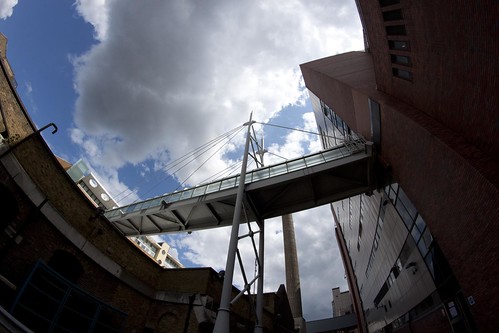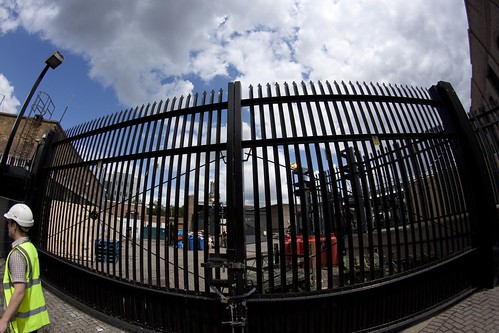I've included the second part of my analysis of population density below, but thought it useful to pull together some reflections on the implications for Wapping. My train of thought is thus:
- LBTH's Core Strategy earmarked Wapping for the provision of 1,470 new units of housing between 2010 and 2020 [LBTH Core Strategy, Appendix, 'Housing investment and delivery programme, p.146]
- 121 Wapping Lane provides c. 400 (I've seen numbers between 382 and 450 quoted), and there have been a handful, such as a gap filling exercise on Penang Street, but nothing else significant.
- 21 Wapping Lane is on a site of 0.8104 ha [21 Wapping Lane planning application]
- The NI site is 7.5 times larger than 21 Wapping Lane, which at the same density would theoretically yield approximately 2900 units.
So, post 21 Wapping Lane, Wapping needs to find space for just over 1,000 units of housing. The only development sites that I'm aware of are:
- 140 Wapping High Street
- Warehouse opposite 140 Wapping High Street
- Two buildings associated with St Patrick's church
- Warehouse/commercial building on Cinnamon Street
- Land opposite the Captain Kidd
- Land by John Orwell
- Two patches of Land on Pennington Street /The Highway (one of which was mooted as a hotel)
Realistically, without demolishing the buildings or building multiple storey buildings, the NI site is realistically going to be the source of these units of housing.
Assuming an average of two people per unit of housing, we're looking a perhaps an extra 3,000 people in Wapping, or an increase of roughly 25 per cent of Wapping's population in 2009, of which perhaps 2,000 will need to be on the NI site.
However, even if we applied the current population density of LBTH (109 people per hectare) to the NI site, that only gives us an increase of 670 residents. So, to bring us to 2,000 new residents on the NI site, it will be necessary to build a cluster of housing nearly three times as dense as the rest of LBTH.
| Number of residents based on maintaining existing densities to area of site |
| | LBTH | NI Cluster | LBTH less Wapping & NI cluster | Wapping+NI | Wapping |
| Including NI site in existing density calc | 668 |
633 |
686 |
458 |
428 |
Excluding NI site in existing density calc |
670 |
708 |
689 |
475 |
444 |
Does any of this actually matter? Well, yes:
- LBTH has decided that Wapping needs 1,400 new housing units
- There is a lack of development space in Wapping, therefore 1,000 of the units realistically need to be built on the NI site.
- LBTH approved 21 Wapping Lane.
- If the density of housing on 21 Wapping lane was replicated over the NI site it would possibly yield 2,900 units of housing (bear in mind that 21 Wapping Lane will have some leisure space).
Now, would LBTH be able to resist the possibility of 2,900 new housing units, relieving its development ambitions?
Realistically, I don't think that the NI site would be as densely built as 21 Wapping Lane- ultimately a development of that size will need open space, which 21 Wapping Lane can avoid providing to the same extent (it is sat on a canal, by Wapping Woods). If there is going to be any significant commercial/office or leisure space, population density will be decreased. Reading some correspondence between St George's planning consultants and LBTH, I get the impression they'll want a reasonable amount of carparking (they object to LBTH's low number of car parking spaces allowed per unit of housing), whereas 21 Wapping Lane is a largely car free development, which may reduce density further.
I'll keep trawling the web and see if anything else is being hinted at.
Comparative population densities
First off, a re-cap of my previous post on population density:
TABLE 1: Areas, population and density
| | LBTH | NI Cluster | LBTH less Wapping & NI cluster | Wapping & NI | Wapping |
| Area | 2,157 | 58 | 1,980 | 176 | 168 |
| Population | 234,765 | 5,981 | 221,607 | 13,158 | 11,716 |
| Density | 109 | 103 | 112 | 75 | 70 |
| Excluding NI site |
| Area | 2,151 | 52 | 1,974 | 170 | 162 |
| Density | 109 | 115 | 112 | 77 | 72 |
The second row of density figures calculate population density by deducting the area of the NI site (6 hectares) from the respective area, to get an idea of the population density when on excludes a large unpopulated area, however, the actual impact isn't that significant.
The next table simple presents the data in the first table in a slightly different way by comparing the population densities of the different areas. For instance, LBTH has a population density of 39 more people per hectare than Wapping. What it does make obvious is that the cluster of LSOAs around the NI site has a relatively high population density compared to Wapping as a whole.
TABLE 2: Differences in densities
| Difference in densities (includes NI site area) - people per hectare |
| | LBTH | NI Cluster | LBTH less Wapping & NI cluster | Wapping & NI | Wapping |
| Wapping | 39 | 33 | 42 | 5 | 0 |
| Wapping+NI | 34 | 28 | 37 | 0 |
|
| LBTH less Wapping & NI cluster | -3 | -9 | 0 |
|
|
| NI Cluster | 6 | 0 |
|
|
|
| LBTH | 0 | | | | |
TABLE 3 is probably the most interesting, as it takes the difference in density from TABLE 2 and applies it to the area (number of hectares) of the relevant location per TABLE 1 to consider how many additional residents would need to be present to equalise population densities.
For example, Wapping's density is 39 people per hectare lower than LBTH as a whole (TABLE 2) which when multiplied by Wapping's area (168 hectares - TABLE 1) gives 6,580 extra people, which is quite a lot. Furthermore, if one were to exclude Wapping & the NI cluster from the calculation of LBTH's density (not counting either Wapping's area or population in the figures of LBTH), you can see that you would actually need to house an extra 7,091 residents (Wapping's low density means that it drags LBTH's density down).
TABLE 3: Additional population change necessary to equalise population densities
| |
|
|
|
| Benchmarked area |
| | | LBTH | NI Cluster | LBTH less Wapping & NI cluster | Wapping+NI | Wapping |
| Area receiving additional residents | Wapping | 6,580 | 5,622 | 7,091 | 834 | 0 |
| Wapping & NI | 6,024 | 5,020 | 6,560 | 0 |
|
| LBTH less Wapping & NI cluster | -6,024 | -17,310 | 0 |
|
|
| NI Cluster | 330 | 0 |
|
|
|
| LBTH | 0 | | | | |
I've calculated the same below, but deducting the 6 hectares of the NI site, however, this doesn't make a massive difference.
TABLE 4: Differences in densities (excludes NI site area)
| Difference in densities (excludes NI site area) - people per hectare |
| | LBTH | NI Cluster | LBTH less Wapping & NI cluster | Wapping & NI | Wapping |
| Wapping | 36.82 | 43.02 | 39.90 | 5.02 | 0.00 |
| Wapping & NI | 31.80 | 38.00 | 34.88 | 0.00 |
|
| LBTH less Wapping & NI cluster | -3.08 | 3.12 | 0.00 |
|
|
| NI Cluster | -6.20 | 0.00 |
|
|
|
| LBTH | 0.00 | | | | |
TABLE 5: Additional population change necessary to equalise population densities (excludes NI Site area)
|
|
|
|
| Benchmarked area |
| | | LBTH | NI Cluster | LBTH less Wapping & NI cluster | Wapping & NI | Wapping |
| Area receiving additional residents | Wapping | 5,962 | 6,966 | 6,461 | 812 | 0 |
| Wapping & NI | 5,409 | 6,463 | 5,933 | 0 |
|
| LBTH less Wapping & NI cluster | -6,079 | 6,158 | 0 |
|
|
| NI Cluster | -321 | 0 |
|
|
|
| LBTH | 0 | | | | |



